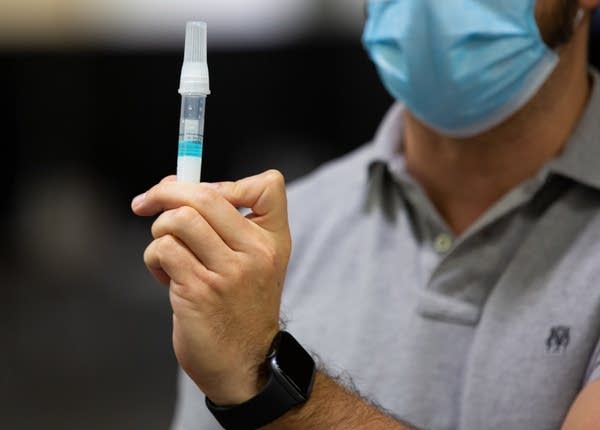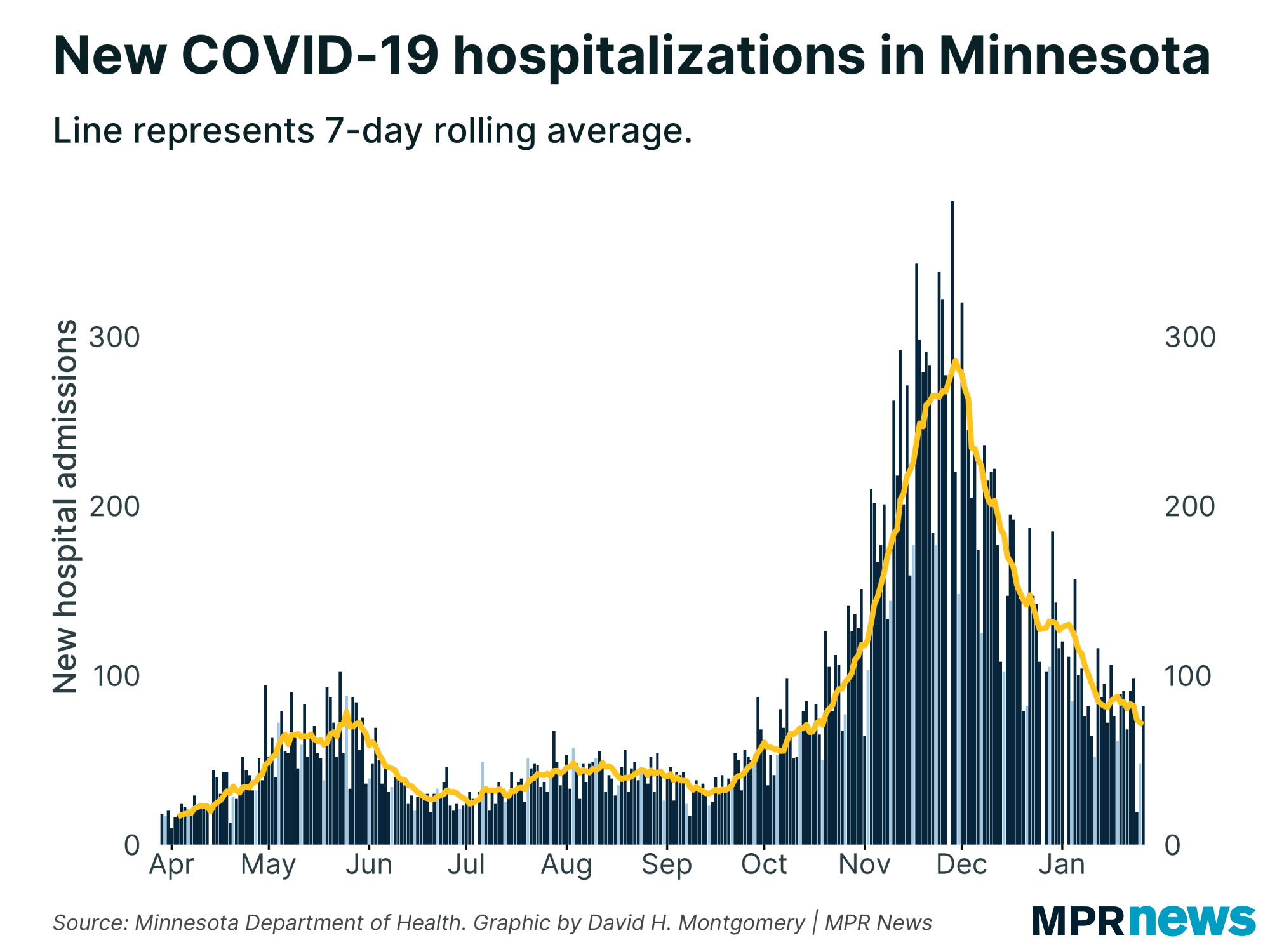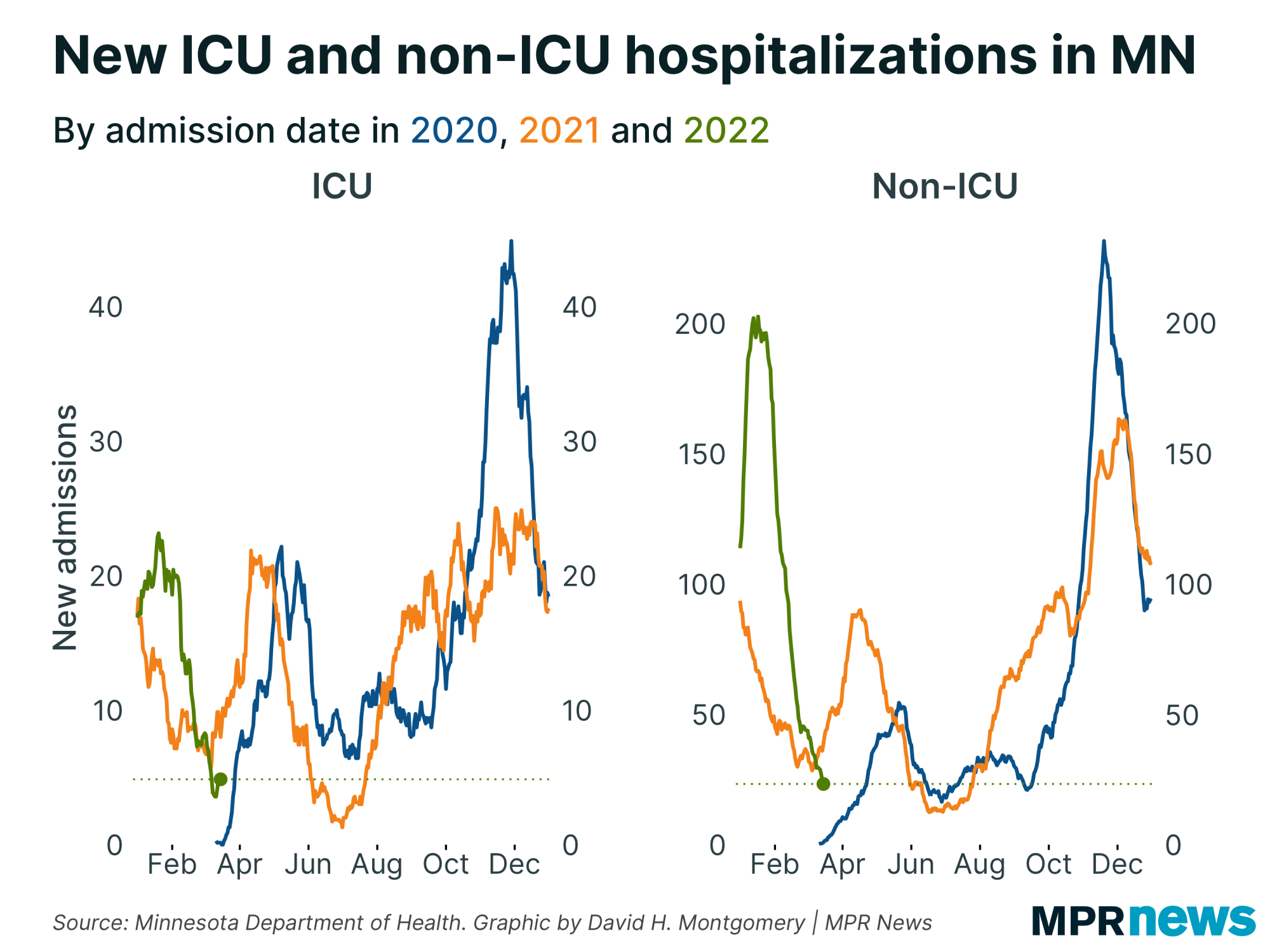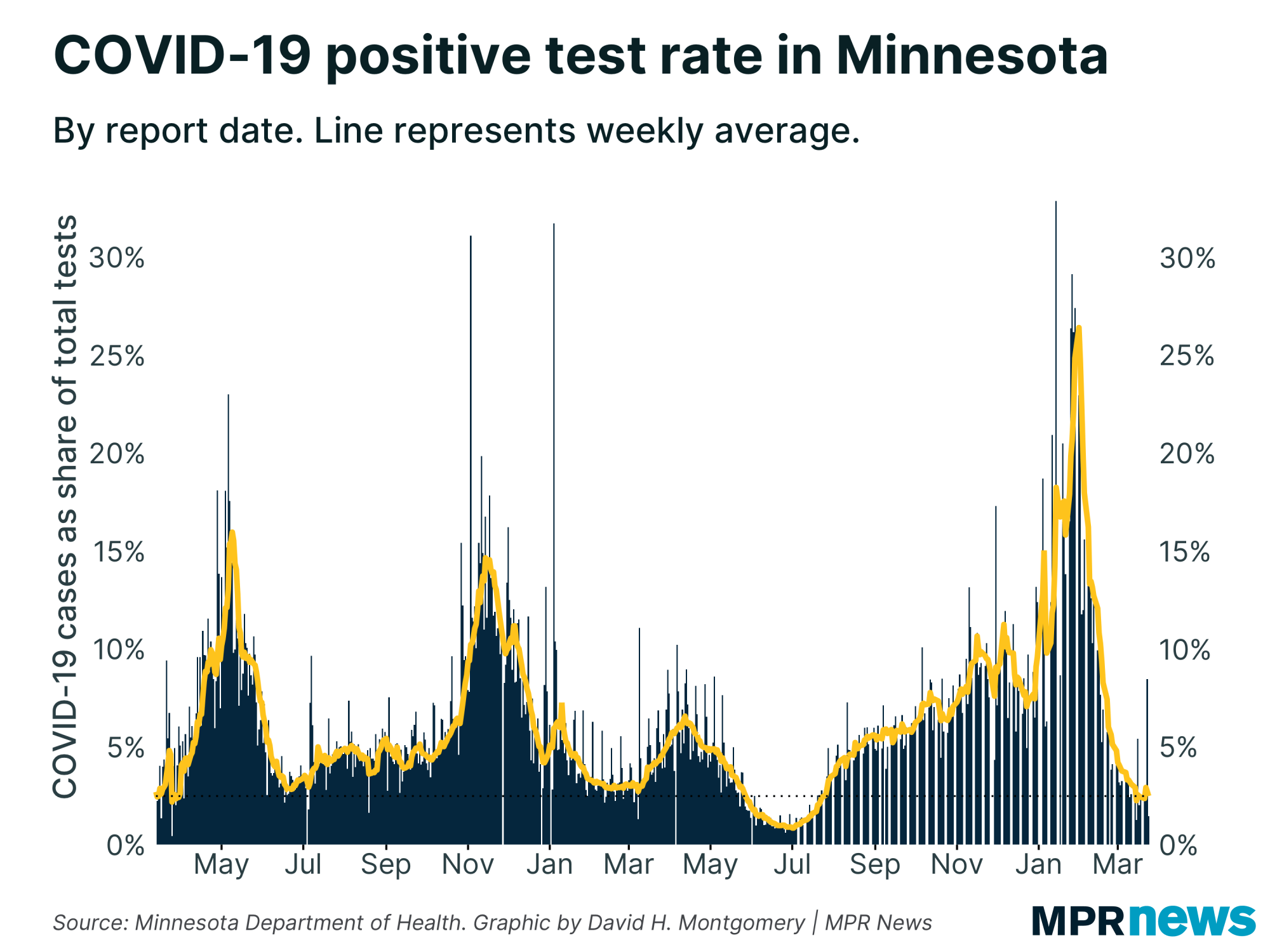Nov. 10 update on COVID-19 in MN: Record new hospitalizations; 23 more deaths

Go Deeper.
Create an account or log in to save stories.
Like this?
Thanks for liking this story! We have added it to a list of your favorite stories.
Updated: 11:55 a.m.
COVID-19 continues its grim November ascent. State health officials on Tuesday reported 4,906 newly confirmed or probable cases, and 23 more deaths.
New hospital admissions tied to COVID-19 hit a new one-day record high, 262. More than 1,200 people are in Minnesota hospital beds now with nearly 250 needing intensive care.

The newest numbers came hours after Gov. Tim Walz rolled out new restrictions on bars, restaurants and big events to try and stem the disease’s rampant spread, which officials say is being fueled by informal gatherings and get-togethers with family and friends, transmitted unknowingly by people who have the virus but do not have symptoms.
Of the 189,681 confirmed or probable cases identified in the pandemic to date, about 81 percent have recovered to the point they no longer need to be isolated.
Turn Up Your Support
MPR News helps you turn down the noise and build shared understanding. Turn up your support for this public resource and keep trusted journalism accessible to all.

The deaths reported Tuesday raised Minnesota’s toll to 2,698. Among those who’ve died, about 69 percent had been living in long-term care or assisted living facilities; most had underlying health problems.
Deaths are rising inside and outside long-term care facilities. The seven-day trend for deaths outside long-term care is at a record high; the similar trend for deaths in long-term care is near the record set back in May.

Caseloads rising across age groups
New cases are up dramatically over the past six weeks in all age groups.
People in their 20s still make up the age bracket with the state’s largest number of confirmed cases — nearly 40,000 since the pandemic began, including nearly 22,000 among people ages 20-24.

The number of high school-age children confirmed with the disease has also grown, with more than 15,600 total cases among children ages 15 to 19 since the pandemic began.
Those numbers help explain why experts remain particularly concerned about teens and young adults as spreaders of the virus.
While less likely to feel the worst effects of the disease and end up hospitalized, experts worry youth and young adults will spread it to grandparents and other vulnerable populations. It’s especially concerning because people can have the coronavirus and spread COVID-19 when they don’t have symptoms.
Active, confirmed cases of the disease remain at record levels.

Virus surges in swaths of rural Minnesota
Regionally, central and northern Minnesota have driven much of the recent increase in new cases while Hennepin and Ramsey counties show some of the slowest case growth in the state.
Northwestern Minnesota no longer has the state’s fastest-growing outbreak. It’s been passed by east-central Minnesota. But new cases are rising at accelerating rates everywhere.

Collectively, rural areas of Minnesota continue to report the most new COVID-19 cases.

Northern Minnesota, once the region least affected by the disease, has also seen its caseload grow dramatically in recent weeks. In Itasca County in northeastern Minnesota, COVID-19 cases are surging to the point that county health officials have suspended individual contact tracing, citing a record high rate of infections through community transmission.
“If you are in a group setting, just assume that someone has COVID,” said Kelly Chandler, department manager for Itasca County Public Health, in a press release.
Latino cases jump
In Minnesota and across the country, COVID-19 has hit communities of color disproportionately hard in both cases and deaths. That’s especially true for Minnesotans of Hispanic descent.
Distrust of the government, together with deeply rooted health and economic disparities, have hampered efforts to boost testing among communities of color, officials say, especially among unauthorized immigrants who fear their personal information may be used to deport them.

Similar trends hold true for Minnesota’s Indigenous residents. Counts among Indigenous people jumped in October relative to population.
Cases among all races and ethnicities continue to rise, although currently the growth is slowest among Black Minnesotans, who reported the most new COVID-19 cases per capita for much of the spring and summer.

‘Minnesota is in a bad spot’
The overall numbers continue to paint a troubling picture of a rapidly worsening pandemic in Minnesota. The latest numbers continue to show rampant spread across Minnesota, not limited to just one region or demographic group, like earlier in the pandemic.

There’s increasing concern about the ability of hospitals to handle more. They were already filling in the summer and fall from normal use, and the surge in COVID-19 patients is putting hospitals in the Twin Cities “near the top of their capacity,” Jan Malcolm, the state’s health commissioner, said last week.
Staffing is becoming a challenge as more health care workers get sick, she added.
“Minnesota is in a bad spot … and it’s going to get worse before it gets better,” Ehresmann told reporters.
While more testing is uncovering more cases, “it’s not the testing that’s the problem,” Ehresmann said. “It’s the sheer fact that we have so much virus circulating in our state.”
Developments around the state
MN opening more sites for free COVID testing
Minnesota is adding more than a dozen new COVID-19 testing locations over the next couple of weeks, including 10 in armories around the state and several locations at Minneapolis-St. Paul International Airport.
On Monday, the state opened a saliva testing site at the Minneapolis Convention Center. Similar testing is already available free of charge at sites in St. Paul, Mankato, Winona, Brooklyn Park, Moorhead, Duluth and St. Cloud.
Health Commissioner Jan Malcolm said the saliva test is as effective as ones that use nasal swabs.
"There's more than one type of saliva test. This one was I believe the first that got FDA emergency use authorization and the reliability is very high,” Malcolm said.
Testing is free and available to anyone who wants to be tested whether they have symptoms or not. The state does not require identification or insurance for saliva testing, but does recommend that patients make an appointment. The tests taken at the Minneapolis Convention Center will be analyzed at a lab in the state and results should be available in 24 to 48 hours, state health officials say.
Other types of testing are available at medical clinics, pop-up sites and temporary locations throughout the state.
Health authorities recommend testing for anyone who is exhibiting symptoms, or people who have been exposed, think they've been exposed or think they need to be tested.
More details are available on the Minnesota Department of Health website.
— MPR News Staff
Record sixth special session set for Thursday
Minnesota lawmakers are coming back into special session on Thursday to decide if Gov. Tim Walz will maintain his emergency powers to manage the coronavirus response.
Walz called the special session in a proclamation Monday because he is again extending the executive order tied to COVID-19 measures his administration has taken. That will remain in place for an additional 30 days unless both the House and Senate vote to unwind the authority. That’s unlikely given that the Legislature is under split-party control.
Walz said the climbing cases require a nimble response.
“This is a dangerous phase of this pandemic. We’re in the midst of a surge in case positivity and hospitalizations,” he said in a written statement. “Extending the peacetime emergency will help ensure we have the tools we need to respond quickly to protect Minnesotans’ health and well-being.”
House Speaker Melissa Hortman, DFL-Brooklyn Park, said she’s expecting a quick special session.
“A real ‘Groundhog Day’ event — so very similar to what we saw in August and September when we were in the quiet period and talked about the emergency powers and did not pass legislation,” she said. “I anticipate that’s what kind of special session it will be.”
The Minnesota Legislature has had an unprecedented five special sessions already this year due to the pandemic. Last week’s election won’t alter party control next year, but Democrats will have a narrower edge in the House and Republicans will lead the Senate by a single seat.
— Brian Bakst | MPR News
N.D. hospitals face bed shortage as COVID hospitalizations spike
North Dakota's coronarvirus risk level has increased across the state as COVID-19 hospitalizations increase. North Dakota reported more than 1,100 new cases of COVID-19 on Monday.
Gov. Doug Burgum said hospital capacity is becoming a serious issue.
"We know that we could be facing a situation in our state in the next two to three weeks where we could be severely constrained on hospital capacity, some parts of the state we're already seeing that,” Burgum said.
But it's not just beds becoming scarce. Burgum said the state is facing a shortage of hospital workers to care for patients in those beds, too. The state is allowing some health care workers who test positive for COVID-19 but don't have symptoms to keep working instead of quarantining, Burgum said.
The governor moved every county in the state into the high risk level on the state COVID-19 monitor. Each risk level carries different mitigation recommendations. High risk includes a recommendation to limit restaurants and bars to 25 percent capacity.
Burgum said hospital capacity could be severely constrained in the next two weeks by a growing COVID-19 caseload. North Dakota hospitals in Fargo and Grand Forks are primary referral hospitals for seriously ill patients in much of northwestern Minnesota.
— Dan Gunderson | MPR News
Top headlines
As cases rise, Walz expected to outline next steps in Minn.'s COVID-19 fight: The governor’s office announced that he plans to address the state at 2 p.m. “to announce next steps in [the] state’s response to COVID-19,” after a week of record-breaking COVID-19 data.
Understanding COVID-19 case rates over time: On Monday, Minnesota reported 3,930 new confirmed cases of COVID-19. Is that bad? Is it OK? How should we interpret those numbers? Figuring it out can be difficult. Data reporter David Montgomery shares one trick he uses to help put COVID-19 figures in context — by making a rough translation into personal risk.
Osterholm joins Biden's COVID task force, hopes to work with Trump team: Dr. Michael Osterholm discusses the task force’s plan to fight the virus, the latest on vaccine development and where we are now with the pandemic.
Asst. health commissioner says ‘we want everyone in the state to get tested’: The number of places where Minnesotans can get COVID-19 tests is growing — and taken together, the range of options can be dizzying. So how do you pick which COVID-19 test to get? To answer that question, MPR News host Cathy Wurzer spoke with Assistant State Health Commissioner Dan Huff.
COVID-19 in Minnesota
Data in these graphs are based on the Minnesota Department of Health's cumulative totals released at 11 a.m. daily. You can find more detailed statistics on COVID-19 at the Health Department website.


